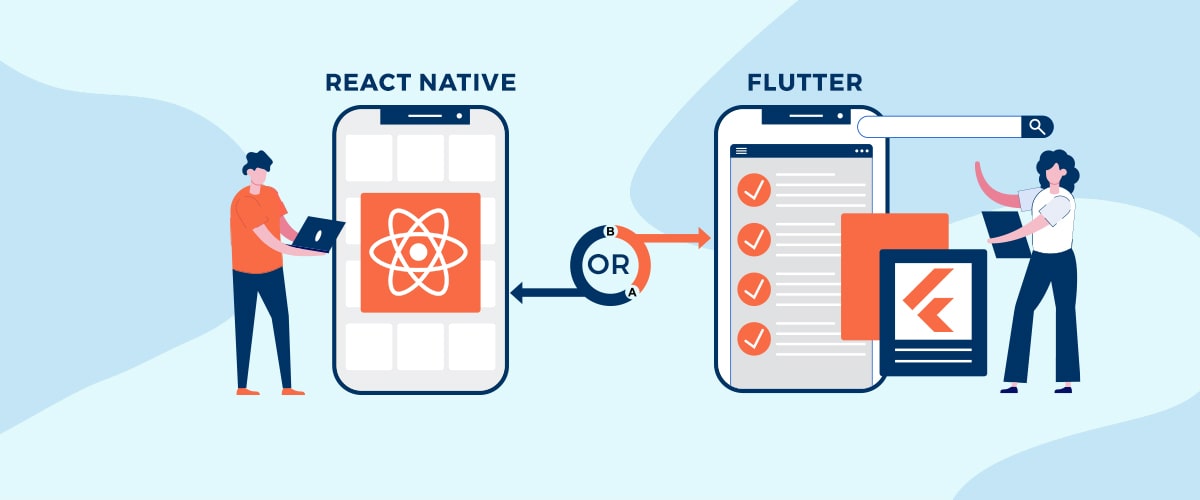With the popularity of smartphones, mobile applications have seen dramatic development. Therefore, mobile apps offer many benefits that are not available on websites. As a result, companies worldwide are forced to invest in cross-platform app development to reach their audiences more effectively. As a result, app development with Flutter and React Native has become one of the most popular cross-platform app development frameworks.
Therefore, if you want to build a great mobile app, you should choose a good framework. However, you need a framework that supports the application development process and allows future updates and technical enhancements.
Everyone is trying to develop a mobile application for their business. Therefore, smartphones’ low cost and high speed and the development of mobile networks that can continuously surf the Internet have contributed significantly to this proliferation. However, to meet user expectations, provide services quickly and easily, and remain competitive in the market, companies are forced to develop native versions of their products for major mobile platforms.
React Native and Flutter as Cross-Platform App Development
They are some of the most commonly used mobile app development frameworks for cross-platform development. However, they have different characteristics that make them unique competitors. Here are some features of the two frameworks.
- Programming language
- architecture
- Installation and initial configuration
- Development Tools and Documentation
- User Interface (UI)
- developer productivity
- Community Involvement
- Support Cl/CD
What is the Flutter framework?
Flutter is a portable UI toolkit – a framework for developing Flutter applications called an SDK, which includes a set of widgets.
What does Flutter do?
Flutter enables cross-platform app development – app development with Flutter makes it easy and exciting to create visually stunning apps for mobile (iOS, Android), web, and desktop.
The uniqueness of Flutter
App development with Flutter makes it easy to create beautiful mobile and desktop apps with rich material design and widgets. However, some critical features of Flutter include
It is an Open-Source Cross-Platform
Open-source application development framework for IOS and Android. For this reason, Flutter is recommended for Android Studio.
Cross-platform development.
This feature allows Flutter cross-platform app development to writing code once, then maintain and operate on different platforms of your choice. This saves developers time, effort, and money.
Hot Reload
When developers make changes to the code, they can immediately see those changes in Hot Reload. Therefore, this means that these changes are immediately visible in the application. This is a handy feature for developers to quickly fix bugs. Therefore, the best erratic applications use the hot reload method.
Affordable native functionality
In short, iOS apps built by Flutter are the best. Therefore, this feature makes application development using native code, third-party integrations, and platform APIs fun and straightforward. It provides easy access to the SDKs for both platforms.
Use of Minimal Code
Flutter mobile application development uses the Dart programming language, compiling with JIT and AOT to reduce startup time, improve functionality, and accelerate performance. Therefore, the JIT improves the development regime and allows the user interface to be reworked without creating a new one. As a result, companies using Flutter have become very popular.
Small tools.
Therefore, Flutter provides customizable gadgets for developing specific projects in Android application development.
React Native
It is an open-source framework to make mobile applications with cross-platform JavaScript.
What does React Native do?
It is mainly applicable to the following applications
- Cross-platform development, including mobile applications
- Create mobile applications in the JavaScript language
- Ability to develop Android and iOS applications in one codebase
- Use the same design as React
JavaScript and React
Apps developed with React Native are not mobile web apps. However, React Native uses the basic UI building blocks standard in iOS and Android apps. In other words, it’s not built in Java, Kotlin, or Swift, but a combination of these building blocks.
React Native brings many advantages to mobile app development. For this reason, the main features of React Native are shown below.
Features of React Native
Hot Reload
You can immediately see which parts of the application code have changed during development. However, if the business logic changes, the reflection will reload on the screen.
Third-Party Library Support
React Native supports many third-party libraries to make your application interactive.
Less Development Time
With React Native, you can reuse code you’ve already written. This feature enables rapid application development. Apps for Android, iOS and Windows platforms are built in a common language, which means apps are deploying and released quickly, reducing time-to-market.
It is also Open-source
React Native is open source, so it’s free to use. Therefore, it is easy for anyone to use.
Cross-Platform
It provides the convenience of “write once, run anywhere,” allowing you to build applications for Android, iOS, and Windows platforms via cross-platform app development.
The Focus of the UI
React Native mainly focuses on the user interface, making the app interface very responsive.
Performance
Code written in React Native compiles the same as native code on all operating systems and runs well on all platforms.



